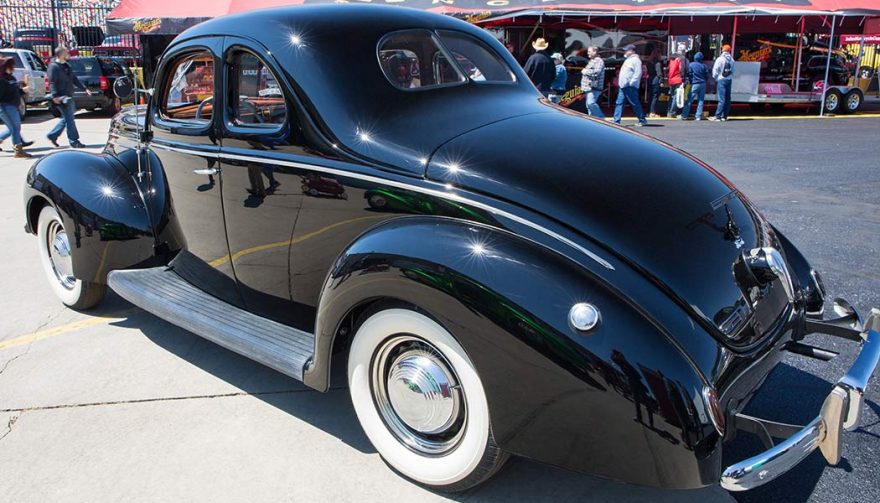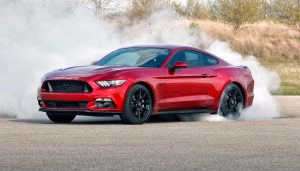
White lighting: The origins of NASCAR go back to the bootlegging days.
NASCAR and the Moonshine Connection
NASCAR, creator of America’s multi-billion dollar stock car racing spectator sport, is host to 17 of the 20 most popular sporting events watched in the country. The organization has an interesting and slightly illegal origin, and it’s proud of it. NASCAR is the first to admit that its phenomenal success is largely due to the exploits and outlaw driving bravado of moonshine runners from the late 1940s and early 1950s. NASCAR’s roots are steeped in the driving skills, mechanical tricks, and just pure craziness that teenage “shine” drivers brought to the game of cat and mouse that they played with US Treasury Department agents (known as “revenuers”).
Life along the Appalachian Trail in the Southeast was never easy. During the decades of the Great Depression and World War II, most folks were dirt poor. Distilling moonshine was the one sure “cash crop” that farmers could count on to put food on the table. Mostly of Scotch and Irish heritage, these farmers saw distilling whiskey as no different than raising corn or breeding hogs. It was just another farming activity. To the federal and state governments, though, that whiskey was subject to a tax, a tax that few of the moonshiners would voluntarily pay.
Distilling moonshine is hard work, not to mention illegal. Distilling moonshine and not being caught by Treasury revenuers is even harder.
But once the product is made, it has to find its way from the back hills of the Carolinas, Tennessee and Georgia to the big markets of Atlanta, Miami, Washington D.C and even New York City. It was that run, that very lucrative game of “catch me if you can,” that motivated so many young mountain boys to smash the pedal to the metal and try their luck running booze just like Robert Mitchum did in the classic moonshine flick “Thunder Road.”
The Cars
Moonshine-running cars had four basic requirements: they needed to be “Plain Jane” in appearance, have an engine powerful enough to haul the load, a suspension stiff enough to carry the load, and have lots of room for cargo.
The 1939 – 1940 Ford Coupe fit the bill perfectly and became a mainstay of the moonshiner’s fleet. The Ford Coupe was easy to find and buy – almost every family in the hills had one. It was also one of the least sexy cars that Ford ever built and fit the “Plain Jane” requirement to a T.
The Ford had a 255 cu. in. flathead V8 rated at 125 hp. Its power could easily be upgraded with an Offenhauser dual or triple carb intake. But the reality was that the contest between lawman and the bootlegger rarely involved pure speed. Local and county budgets kept cops in cheap compact six cylinder cars with top speeds of about 80 mph, compared to the moonshine runners’ 150 mph V8s.
No matter how fast that Ford could fly, though, it could not outrun the two-way radio in the revenuers’ cars. As a result, the contest went to the driver who had the best knowledge of the red clay tracks and trails that crisscrossed the hills, as well as the driving skills to negotiate the twists and turns at high speed without ending up in a ditch or rolling down the mountainside.
Just as important as the driving skills on the switchbacks was the quality of the Ford’s handling. When you are hauling 3,400+ pounds of whiskey over potholed roads, you need a suspension that won’t tip over in the turns or bottom out in the ruts. Double springs and extra bracing were common additions to a bootlegger’s ride.
The 1939-40 Ford Coupe could also haul a large load. It had a generous trunk but that was just the beginning of the storage space. For bootleggers who ran at night, the front and back seats could be removed to make space for extra cargo. A handcrafted bucket seat would be provided for the driver, with the rest of the space dedicated to cargo, usually gallon containers made out of tin with cork stoppers rather than the traditional (and breakable) mason jars.
Moonshiners who traveled during the day in traffic had to be more discreet. This led to secret tanks being installed inside gas tanks, trunks, floorboards and even externally under the vehicle. Depending on the configuration, a moonshine runner could carry between 200 and 600 gallons. With a markup of $0.30 to $0.40 per gallon, a single run could add up to serious money for these kids from the hills.
Boys And Their Toys
Any time you have a group of guys with hopped-up rides, you know there are going to be challenges for bragging rights. The moonshine drivers were no exception. Even though they risked arrest, they couldn’t resist the urge to gather together and race on the weekend to prove their stuff. Sometimes it was just a drag race down a stretch of road, but the more ambitious of the group cut crude tracks out of the hillsides to accommodate more contestants (and bigger bets).
Soon these amateur races were attracting gas station mechanics, farmers and anybody else who had a car they thought was hot. Suddenly there was a new place to go after church on Sundays in Appalachia.
In the late 1940s and early 1950s, stock car racing was becoming a popular event in parts of the South. Small dirt tracks dotted the countryside throughout the Southeast and Florida. Stock car racing was not considered a real sport, but instead ranked right up there with carnivals. Drivers were naïve, promoters were frequently crooks, rules varied from venue to venue, and the only people that really got their money’s worth were the spectators, who loved the crashes.
But thanks to a former bank teller and self-taught mechanic and driver named “Big” Bill France, who had an affiliation with the Daytona Beach Speedway, stock car racing was about to change. Bill saw the marketing potential of a unified racing circuit, not only in terms of drawing huge crowds but also sponsorships. There was money to be made legitimately – all he needed was an agreement among track operators and drivers. In 1948 that’s exactly what he negotiated, and NASCAR was born.
Bill France was a promoter, if nothing else, and he knew he needed a real draw to bring the crowds to his new brand of racing. What could be better than to have the outlaw drivers who ran moonshine down the hills competing with “professional” race car drivers for sizable purses? With that in mind, he worked his contacts, and soon found bootleg racing teams showing up to participate.
Early NASCAR Champions
The moonshine drivers found a home racing in NASCAR. There were the Flock brothers, Bob, Fonty and Tim, whiskey trippers all, before they became NASCAR pioneers. From Wilkes County, North Carolina, the legendary Junior Johnson, fresh from prison, started winning at a prodigious rate, racking up 50 victories. Junior gave up driving but continued to participate in NASCAR’s success as a team owner, sponsoring the likes of Cale Yarborough and Darrell Waltrip.
Everybody wanted to see these bad boys race, not just because of their notoriety, but because they truly knew how to drive. NASCAR had combined the best of professional auto racing with the risky, raucous moonshine-running behavior that would be its trademark for decades to come.
Roots in the moonshine business? Hell yes! And the rest, as they say, is history.





